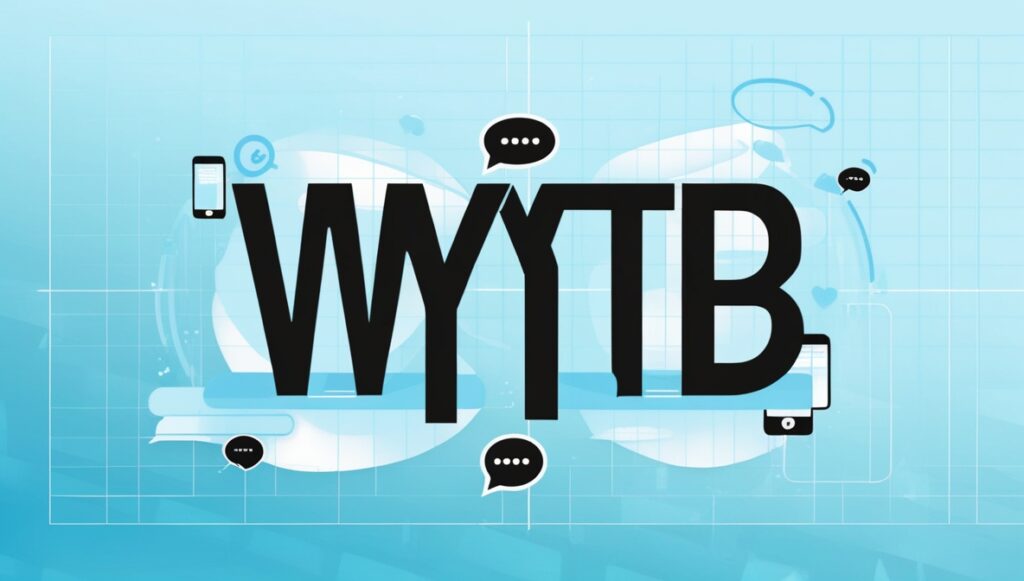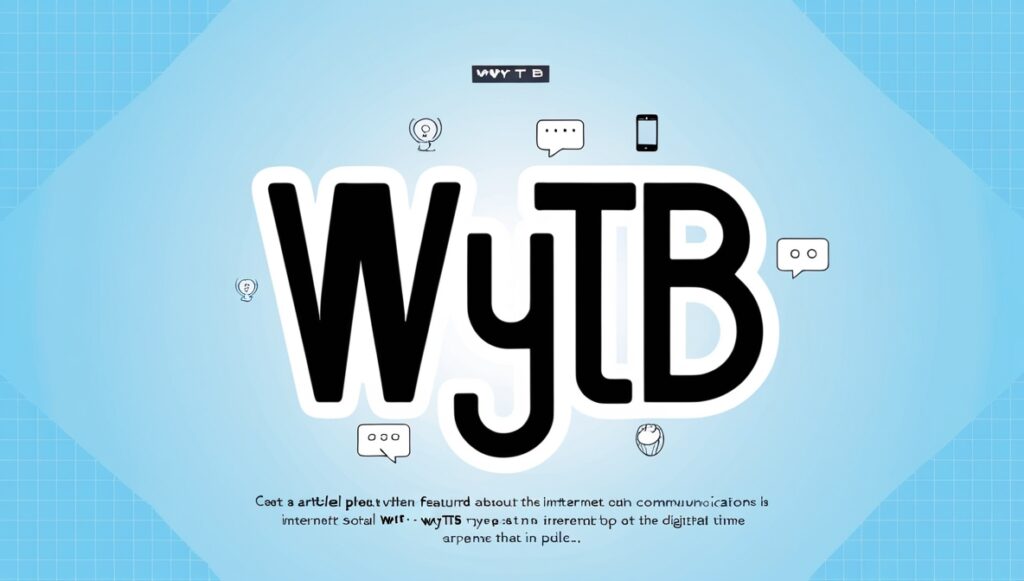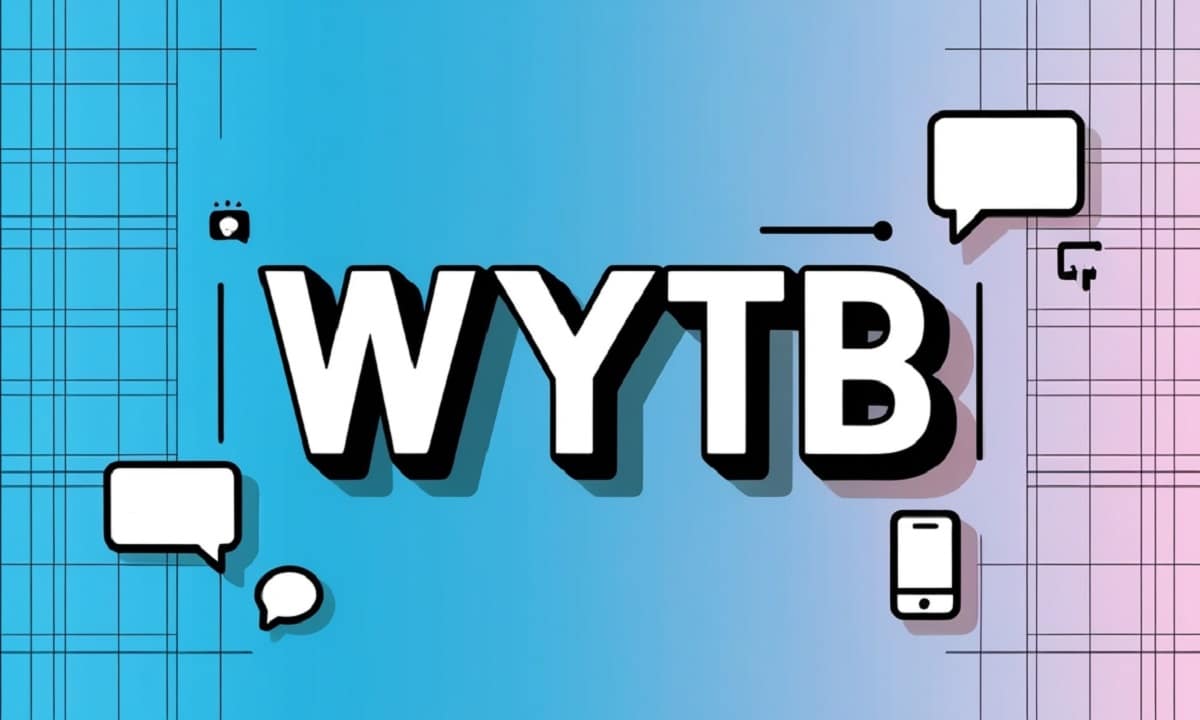Digital communication keeps evolving, and every year new slang phrases emerge. One of these is WYTB, a texting acronym that confuses many readers at first glance. Whether you’ve seen it in a group chat, on Twitter/X, or inside a dating app, WYTB has specific contextual meaning that depends on tone and setting. This guide will explore its definition, origins, usage, cultural connections, and WYTB meaning in text in detail.
Definition & Core Meaning of WYTB
The acronym WYTB stands for “Would You Text Back”. It is a shorthand often used in casual digital conversations.

- At its simplest, WYTB asks: Am I worth texting back?
- It can express curiosity, flirtation, humor, or even mild frustration.
- The phrase is direct yet informal, designed for fast-paced chats.
Here’s how it looks in text:
Person A: You left me on read last night... WYTB?
Person B: Haha of course, just got busy.
Why it Matters
Decoding WYTB involves acronym/abbreviation recognition. The term is part of broader slang & colloquial language processing, where short forms replace longer phrases to save time.
Background & Origins of WYTB
Texting acronyms flourished during the SMS boom of the late 1990s and early 2000s. Limited character counts pushed users to shorten words.
WYTB gained traction later, influenced by:
- SMS texting / early social media platforms like MSN Messenger, AIM, and Facebook Chat.
- The rise of Twitter/X where character limits forced brevity.
- Dating apps where users often tested interest with short, punchy acronyms.
Pop Culture Influence
Another layer is its overlap with “What You Talking Bout?”, a phrase tied to Diff’rent Strokes, a famous sitcom from the late 70s and 80s. The catchphrase “Whatchu Talkin’ ’Bout, Willis?” became iconic and influenced modern slang. Some communities still interpret WYTB in this older sense through abbreviation expansion / normalization.
Usage in Various Contexts
WYTB adapts to multiple communication settings. Understanding contextual meaning / word-sense disambiguation is key.
Casual Texting Among Friends
- Playful banter or teasing someone for ignoring a message.
- Example: “I told you a secret and no reply? WYTB?”
Flirting & Dating Conversations
- Used as a clarification phrase testing romantic interest.
- Example: “We matched yesterday, WYTB or nah?”
Social Media Captions or Memes
- Posted under selfies with a cheeky vibe.
- Example: Instagram caption: “Feeling cute, WYTB?”
Group Chats
- A way to poke fun at someone’s slow replies.
- Example: “Still waiting for John’s answer… WYTB bro?”
Tone & Nuances of WYTB
Tone dramatically shifts the perception of WYTB. That’s where pragmatics and sentiment/emotion analysis come in.
- Playful tone → Teasing, flirty, lighthearted.
- Confrontational tone → Frustrated, passive-aggressive.
- Curious tone → Genuine inquiry.
Emojis and punctuation reinforce meaning:
- WYTB 😊 = friendly.
- WYTB 😏 = flirty.
- WYTB… = annoyed.
Common Misconceptions & Clarifications
People often misinterpret WYTB. Here are clarifications:
- Mistaken for “Will You Text Back”. The difference is subtle but meaningful.
- Confused with WYD (What You Doing) or WTB (Want to Buy).
- Sometimes mixed up with slang like SPWM or WTMS in gaming chats.
Key Point: WYTB is not always romantic. In many cases, it’s simply casual.
Similar Terms & Alternatives
WYTB connects to a family of chat acronyms.
| Acronym | Meaning | Usage Example |
|---|---|---|
| WYD | What You Doing | “Bored rn, WYD?” |
| WYA | Where You At | “Party’s started, WYA?” |
| LMK | Let Me Know | “LMK if you’re free.” |
| HBU | How About You | “I’m fine, HBU?” |
These alternatives serve similar conversational roles, but WYTB emphasizes response-worthiness.
How to Respond to WYTB
Replying depends on intent. Good responses show awareness of conversational analysis & dialogue act classification.
Playful Responses
- “Of course, you’re top of my list.”
- “I’d text back twice.”
Direct Responses
- “Yes, I would.”
- “Definitely, you seem fun.”
Polite Declines
- “Sorry, I’m not really looking to chat right now.”
- “Not sure, but hope you’re doing well.”
Regional & Cultural Differences
WYTB is most common in North American texting culture. Youth in the United States frequently use it in dating contexts.
- UK: Less popular, but understood due to global meme culture.
- Asia: English-speaking youth adopt it in gaming and social apps.
- Generational split: Gen Z use it casually, Millennials understand but use less, older groups rarely engage.
AAVE & Code-Switching
In some circles, WYTB overlaps with AAVE (African American Vernacular English) phrasing, especially when connected to “What You Talking Bout?” context. This involves code-switching between informal and formal registers.
Comparison with Similar Terms in Dating Culture
Dating apps thrive on acronyms. WYTB mirrors the “swipe right” psychology.
- WYTB vs. “Text Me Back” → WYTB is shorter, more playful.
- WYTB vs. “Hit Me Up” → WYTB questions worthiness; HMU suggests availability.
This behavior reflects intent detection in digital dating: people want confirmation of attraction without wasting words.
Usage in Online Communities & Dating Apps
WYTB appears across online communities.
- Tinder, Bumble, Hinge: Flirty bios like “WYTB if we matched?”
- Discord & Gaming communities: Used in chatrooms to tease slow players.
- Reddit & TikTok: Meme content with sarcastic captions.
- Twitter/X: Short posts testing engagement.
This falls under topic modeling of texting slang, online communities, gaming spaces.
Hidden or Offensive Meanings (Myths & Realities)
Some claim WYTB hides vulgar meanings. Most of these stem from misunderstanding or deliberate trolling.
- Myth: WYTB stands for explicit content.
- Reality: Context proves it’s about texting back or “What You Talking Bout.”
Misinformation spreads quickly, making named entity recognition (NER) important to separate truth from rumor.
Suitability for Professional or Formal Communication
WYTB is unsuitable for professional environments.
- Risk: Appears immature or unprofessional.
- Better Alternatives:
- “Please confirm when available.”
- “Looking forward to your reply.”
This highlights register/style classification—WYTB belongs in informal, casual registers only.
WYTB in Pop Culture & Media
WYTB ties to several cultural references:
- Diff’rent Strokes catchphrase “What You Talking Bout, Willis?”
- Viral TikTok sound clips using “WYTB?” in humorous edits.
- Instagram memes captioned “New haircut, WYTB?”
This reflects pop culture reference extraction, showing how slang migrates from television to online communities.
Practical Tips for Using WYTB Correctly
To avoid awkward miscommunication, follow these guidelines:

Do’s:
- Use with friends or romantic interests.
- Add emojis for clarity.
- Keep tone playful.
Don’ts:
- Don’t use in work emails.
- Avoid sending without context.
- Don’t assume everyone knows it.
Table: Best Practices
| Situation | WYTB Usage | Recommendation |
|---|---|---|
| Dating app chat | Flirty | Add emoji or GIF |
| Group chat | Playful | Use humor |
| Workplace | Not suitable | Replace with professional phrase |
| Social media caption | Cheeky | Works well with selfies |
FAQs
What does WYTB mean in texting?
It means “Would You Text Back.”
Is WYTB flirty or just friendly?
Both. Tone and context decide.
How do I reply to WYTB?
Playful, direct, or polite—depending on your intent.
Is WYTB appropriate for professional chats?
No, it belongs to informal settings only.
Do people still use WYTB in 2025?
Yes, especially in dating and youth online communities.
Does WYTB mean the same on Snapchat and TikTok?
Yes, though TikTok often uses it humorously.
Conclusion
WYTB is more than a texting acronym. It reflects the evolution of digital communication, cultural slang, and online humor. Its meaning hinges on context, tone, and intent, which makes pragmatics and emotion analysis crucial for proper interpretation.
When you see WYTB, remember it’s a playful, sometimes flirty, sometimes sarcastic shorthand. Use it in casual conversations, avoid it in professional ones, and always pair it with clear tone markers like emojis.
In today’s fast-moving texting culture, WYTB isn’t just about Would You Text Back—it’s about how digital language captures curiosity, personality, and connection in just four letters.

